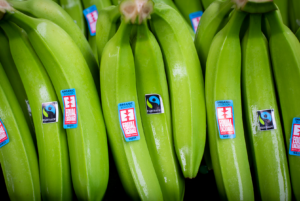Choosing Fairtrade makes a difference!
In March we are featuring Fairtrade Bananas for $0.99/lb
 Photo courtesy of Equal Exchange
Photo courtesy of Equal Exchange
- Fairtrade banana producers are paid a Fairtrade Minimum Price that acts as a safety net against falling prices. This price varies by region, factoring in local conditions and aiming to cover the average costs of sustainable production.
- Plantation workers and small-scale banana farmers also receive a Fairtrade Premium – an extra sum of money that farmers and workers invest in business or community projects of their choice. Banana workers have often used the Premium to improve their housing, build schools and clinics, or offer other benefits they see a need for.
- The Fairtrade Standards are designed to improve employment conditions and protect the rights of workers in the large plantations where the majority of export bananas are grown. In recent years Fairtrade has undertaken pioneering work to define and progress toward living wages for banana workers.
- For smallholder farms, Fairtrade supports these banana growers to improve their income and their bargaining position in banana supply chains that are often dominated by larger entities.
 Photo courtesy of Equal Exchange
Photo courtesy of Equal Exchange
Season: Bananas are grown in tropical areas and can produce nearly year-round, so seasonality is not particularly relevant to the fruit. Bananas are not grown in California.
Flavor: The flavor changes as they ripen. Green bananas are more starchy, very firm and less sweet. As they ripen the taste has been described as having melon, pineapple, candy and clove flavor notes. Yellow bananas have higher sugar concentrations and therefore taste sweeter. Finally, when the peel has become brown, the banana contains notes which are reminiscent of vanilla, honey and rum and the texture is very soft.
Storage: Ripen green bananas on the counter. You can also store them on the counter – but note that they will continue to ripen, and sometimes quickly, depending on how warm it is. If they are too green for you then put them in a plastic bag with an apple to help ripen them.
You can also use bananas’ ethylene gas to your advantage: to ripen a hard avocado overnight, stick it in a paper bag with a ripe banana. The banana’s ethylene gas will work its magic on the avocado, making it perfectly ripe and ready for your next batch of guacamole.
How to use: The most common way to eat bananas is of course, out of hand. But they’re also used for a variety of sweet and savory dishes. Very ripe bananas are perfect for baking in dishes such as Banana Bread.
Bananas freeze beautifully — just peel them and stick them in a zip-top bag for use in smoothies or banana ice cream. If you’re going to freeze them, go one step further and make chocolate covered bananas for an instant dessert.
Nutrition: Bananas are really, really good for you! One medium-sized banana will give you about 12 percent of your daily fiber needs, plus lots of Vitamin C, Vitamin B6, potassium and manganese. Bananas even have a bit of protein, iron and calcium.
Our stores only carry organic produce!

